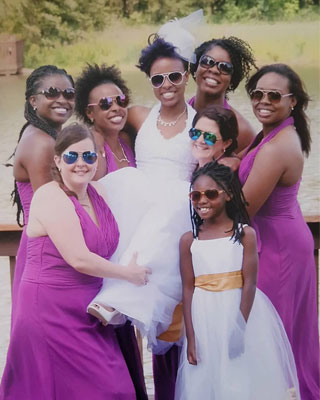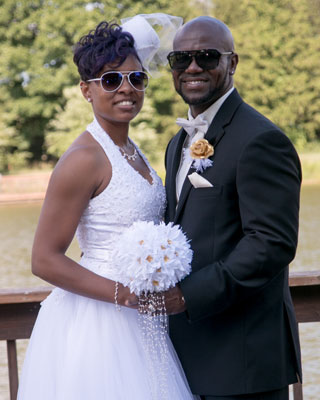The day of Te’ LaVette’s wedding was busy, but not in the way she had planned. Te’ had a bad habit of sleeping in her contact lenses. She got away with it for some five years. But it caught up with her – on her wedding day. Within 24 hours, what started as an annoying pain in her left eye, progressed to blindness.
On her Big Day, Te’ woke with a red, irritated eye. At first, she wasn’t too concerned. She hurried on her way to her 6 a.m. hair appointment. A couple hours later, hair perfect, the hairdresser drew the blinds, letting in the morning sun. The pain was excruciating. Te’s eye had become extremely sensitive to light.
Instead of getting her makeup done, she headed to urgent care. But it wasn’t the right urgent care for her insurance carrier. She got bounced around to another location before she ended up at MetroHealth Medical Center in Cleveland, Ohio, where she was prescribed an antibiotic.
Medication in hand, she hopped in the car with her mom, because she was unable to drive at this point, and raced to her wedding. She made it, with 30 minutes to spare. No makeup, but that was OK. She’s a crier, and she anticipated happy tears that afternoon. Her only concern was her pictures. Her bridesmaids took care of that worry. It was an outside wedding, so the wedding party wore sunglasses with their violet sundresses.
While her eye still hurt, the rest of her wedding day went off as planned. But in the morning, things took a turn for the worse.

Te' on her wedding day with bridesmaids.
Honeymoon Trip Cancelled for ER Trip
“When I got up in the morning, I couldn’t see out of my left eye,” Te’ said. “I was scared.” The honeymoon would have to wait. She rushed back to MetroHealth. This time, she saw ophthalmologist Thomas Steinemann, MD, who diagnosed her with a corneal ulcer.
“He told me we have to take care of this now or I would lose my eyesight. My heart just fell. It’s my eyesight. I said, ‘Oh, no, no, no. That can’t happen."
So, she canceled her honeymoon plans and became the perfect patient. She spent the next four days instilling two types of eye drops in her eye, every 30 minutes, around the clock.
“I probably missed it by 15 minutes a couple of times because I was so tired,” Te’ said of her strict treatment regimen. “I was also on Percocet for the pain. It was four days of no sleep.”
Tens of thousands of contact lens wearers develop eye infections every year in the US. Most are minor infections, easily treated with an antibiotic drop. But up to 1 out of every 500 contact lens wearers, each year develop serious eye infections that can lead to blindness, according to the Centers for Disease Control and Prevention (CDC).
"It’s the most feared infection for contact lens wearers. It’s very destructive. It can destroy things pretty quickly.” - Dr. Steinemann
Sleeping in any type of contact lens (including extended wear, continuous wear or overnight wear) increases by 6 to 8 times the risk of getting a serious type of corneal infection like the type Te’ developed.
Race Against Time to Protect Te’s Vision
Te’s eye was infected with a bug called Pseudomonas aeruginosa, an extremely aggressive infection, explained Dr. Steinemann.
“It’s the most feared infection for contact lens wearers. It’s very destructive. It can destroy things pretty quickly,” Dr. Steinemann said. “It’s like setting a bomb off in the eye. It makes the eye very red, very painful and very light sensitive. It’s miserable to go through.”
Even though it develops quickly, it takes a long time to get the infection under control. Even if the infection is cured, many patients are left with a significant scar on their cornea that decreases their vision. In some cases, the scar is so bad, a corneal transplant is required.
Good news is, contact lens-related eye infections are preventable. Nearly all infections, from mild to severe, are related to poor hygiene habits. A recent survey from the CDC showed that 99 percent of contact lens wearers who responded to their survey reported engaging in at least one poor hygiene habit that puts them at an increased risk for eye infection:
- Sleeping overnight in contact lenses (50.2%)
- Napping in contact lenses (87.1%)
- Topping off disinfecting solution (adding new solution to existing solution in the contact lens case, 55.1%)
- Extending the recommended replacement frequency of lenses (49.9%) or cases (82.3%)
- Showering (84.9%) or swimming (61.0%) in contact lenses
- Rinsing their lenses in tap water (35.5%) or storing their lenses in tap water (16.8%)
"Do not ever sleep in your contact lenses." - Te' LaVette
“People take extreme liberties with contact lenses,” Dr. Steinemann said. “They don’t realize that they are medical devices. No one is perfectly compliant with proper wear and care. Most of the time, people get away with it. But you take this risk every day of your life. It adds up.”

Te' with her husband.
Vision Scare Turns Te’ Into an Advocate
More than 45 million Americans wear contact lenses. When cared for properly, contact lenses can provide a safe and effective way to correct vision, Dr. Steinemann explained. “If you’re careful, you won’t get into trouble. It’s like taking care of your teeth. It’s a daily commitment.”
Te’ was careful when she started wearing contacts as a teenager, but once she started using 30-day contact lenses, she started sleeping in them.
“I just got lazy,” she explained. “Nothing bad had happened to my eyes. This one time, my eyes said, ‘no, not ok.’”
It took a month and a half to regain vision in her left eye. Her vision is still poor. The “Big E is blurry,” she said, but with glasses or contact lenses, she can at least drive again. Her experience has turned her into an advocate for proper contact lens wear and care.
“Do not ever sleep in your contact lenses,” Te’ advised. “You need to take care of your eyes. They’re the only set you have. You don’t realize how much you miss something until it’s gone. I wouldn’t wish it on anybody.”